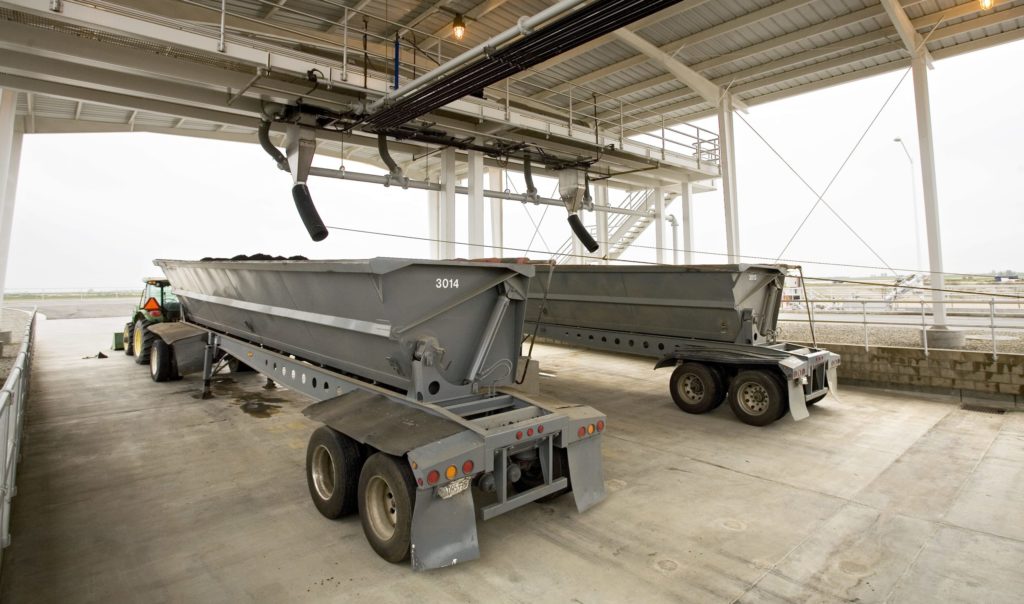
Ironhouse Sanitary District biosolids dewatering (photo by ISD)
Coverage of PFAS is supported by Carollo.
In 2018, the media seized on a story about a small dairy farm in Maine that was forced to no longer produce milk due to sludge and biosolids spread on the farm as fertilizer under a state-sponsored program from 1983 to 2004. Wastewater utilities were quickly blamed for another environmental disaster, not of their own making.
The case casts a negative light on the use of biosolids. In this situation, however, the real culprit was not the organic material of wastewater, or the process used to clean it,
but rather contamination introduced by a manufactured fluorinated compound known generically as PFAS and found in a variety of industries.
PFAS is shorthand for polyfluoroalkyl and perfluoroalkyl Substances, a family of more than 3,000 manufactured chemicals that have been widely used since the 1940s because of their resistance to heat, water, and oil.

Greg Kester, CASA
Greg Kester is the director of renewable resource programs for the California Association of Sanitation Agencies (CASA) and an expert on biosolids. Through his work, he is familiar with the Maine dairy case and the effects of PFAS on the environment and policies related to it.
“The Stoneridge Dairy farm in Maine that was contaminated with PFAS apparently received a land application of biosolids, as well as paper mill sludge,” Kester said.
Kester explained that the Stone dairy was the first to come to public attention, and its discovery led to a statewide moratorium on the land application of biosolids.
“This is despite the fact that the dairy received both municipal biosolids and paper mill sludge (inaccurately termed “biosolids” throughout both cases), and evidence has shown that only the fields which received paper mill sludge had contaminated levels of PFAS, and was thus the cause of the elevated levels in the milk,” he said.
Media outlets covering the case have continued to blame the municipal biosolids despite being informed of the conflicting evidence. Currently, land application of both biosolids and septage, as well as the sale of any product containing them, is banned in the state of Maine.
PFAS is commonly known as a “forever chemical” because it very slowly degrades, Two PFAS compounds — Perfluorooctane Sulfonic Acid (PFOS), which was specifically present at the Maine dairy, and Perfluorooctanoic Acid (PFOA) — can be found in minute concentrations in every person’s bloodstream. Both compounds have been phased out of use since 2002.
However, studies conducted since the 2002 elimination of PFOS and PFOA have found them at decreasing concentrations in the blood of human subjects.
Since the creation of the Clean Water Act in 1972, discoveries such as the harmful consequences of PFAS contamination have placed wastewater treatment plants in the middle between industry sources of contamination and treated waste products that are eventually released back into the environment.
“I have not heard of any environmental issues in California with biosolids like those found in Maine,” Kester said. “However, the wastewater sector and the state are compelled to come up with solutions out of due diligence.”

Biosolids loading (Photo by Paul Cockrell)
While working on PFAS and drinking water issues is a top priority for California and the U.S. Environmental Protection Agency, Kester does not believe the state will issue any special regulations concerning biosolid PFAS contamination in the coming year.
The EPA is currently working on two federally regulated risk assessment models for biosolids, he said. These models provide the basis for the Standards for the Use or Disposal of Sewage Sludge, 40 CFR Part 503, which regulates sewage sludge (biosolids) that is applied to land, incinerated, or placed on a surface disposal site.
According to the EPA website, the standards include pollutant limits, requirements for pathogens, and vector attraction reduction, among other provisions. The biosolids program has developed a framework to evaluate risks from exposure to chemicals in biosolids.
The framework consists of three steps: prioritizing chemicals for assessment, screening for human health and environmental hazards, and performing a refined risk-assessment for chemicals that fail the screen.
“The second step is a conservative risk screening model,” Kester said. “If a constituent passes the screening test, it is considered safe and no further action is required. If it
is flagged in the screening test, then it undergoes a full probabilistic risk assessment to determine if it needs to be regulated in biosolids and at what level.”
Written into the risk assessment models, the EPA says that its top priority for the biosolids program is assessing the potential human health and environmental risks posed by pollutants. However, they reiterate that “the pollutants found in biosolids vary in space and time, depending on industrial and other inputs to individual wastewater treatment facilities.”
The EPA Science Advisory Board has appointed an expert biosolids panel, of which Kester is a member, to review the revised models. While the panel is waiting to begin the review process pending further refinements, Kester said that the panel will have roughly six months to complete its review and EPA hopes to have a public comment period for the models during 2023 and decisions made by 2024.
State Water Board PFAS tracking map
In July 2020, the State Water Resources Control Board sent an investigative order to more than 200 publicly owned treatment works (POTWs), requiring them to sample their influent, effluent, and biosolids every quarter for one year. The agency asked each facility to report on industrial, residential, and commercial flow volumes into their plants and the industrial types contributing to influent waste.
The information collected can be found on a GeoTracker map2 on the State Water Board’s website.
Once the information was made public, multiple agencies, including OC San with their partner Ramboll, as well as CASA, with the help of engineering consultants CDM Smith, worked to identify PFAS contamination in California. The data analysis showed that many PFAS components were frequently not detected in the POTW sample.
Not only can the data collected from the survey help determine the amount of PFAS contamination, but where available, it also can help identify the original sources of the PFAS contamination. The map is frequently updated and presents PFAS analytical data as it is accepted into the database by the state’s Regional Water Quality Control Boards.
Several California agencies are working on treating and mitigating PFAS contamination. However, source control is one of the most cost-effective and practical answers to this very complex problem. In late September, Gov. Gavin Newsom approved two pieces of legislation regarding PFAS in cosmetic and textile products.
Assembly Bill 2771 updates existing law beginning Jan. 1, 2025, to prohibit the sale, delivery, holding, or offering for sale of any cosmetic product that contains intentionally added PFAS. AB 1817 expands an existing law governing food packaging that contains regulated PFAS substances to include textile articles as well. The new law, which also goes into effect in 2025, requires the manufacturer to use the least toxic alternative when replacing the PFAS in the product.
“We are very grateful to the governor for signing both of these measures into law,” Kester said.
1 Standards for the Use or Disposal of Sewage Sludge, 40 CFR Part 503 can be found at www.epa.gov/biosolids.
2 State Water Resources Control Board PFAS map can be found at geotracker.waterboards.ca.gov.